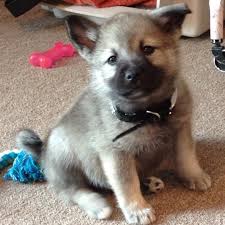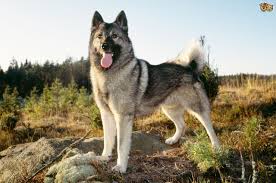Norwegian Elkhound
General
This is an ancient breed going back to approximately 4000 - 5000 B.C and originating in Norway. It was bred to be a hunter and has fantastic stamina which was needed to cope with the sub-acrtic climate. This dog was known to be fearless (and still is) and was used to hunt bears which were found in the area in those days. It is a beautiful looking dog, with a definite wolf-like appearance and is the National Dog of Norway.
As the bear became less common, it was used to hunt elk - which Amercians call the 'moose' and in Norwegian 'elg' means moose. So it could be that this dog was known as a moose hunter and not an elk hunter.
It was also used to hunt a large variety of other game due to its exceptional hunting abilites, which include scent, sight, hearing and mental and physical prowess. Other animals it was used to hunt are the mountain lion, badger, fox, raccoon, rabbit, lynx and even wolf.
As time went by and there was less hunting undertaken, this breed became a very competitive show dog, a wonderful watch and guarddog, sled dog, pack dog, and most importantly, a valued, loyal and loving family companion dog.
This breed can also be full of fun and are well known for their intelligence and their empathy towards their people - picking up on emotions and comforting their owners when needed.
This is an ancient breed going back to approximately 4000 - 5000 B.C and originating in Norway. It was bred to be a hunter and has fantastic stamina which was needed to cope with the sub-acrtic climate. This dog was known to be fearless (and still is) and was used to hunt bears which were found in the area in those days. It is a beautiful looking dog, with a definite wolf-like appearance and is the National Dog of Norway.
As the bear became less common, it was used to hunt elk - which Amercians call the 'moose' and in Norwegian 'elg' means moose. So it could be that this dog was known as a moose hunter and not an elk hunter.
It was also used to hunt a large variety of other game due to its exceptional hunting abilites, which include scent, sight, hearing and mental and physical prowess. Other animals it was used to hunt are the mountain lion, badger, fox, raccoon, rabbit, lynx and even wolf.
As time went by and there was less hunting undertaken, this breed became a very competitive show dog, a wonderful watch and guarddog, sled dog, pack dog, and most importantly, a valued, loyal and loving family companion dog.
This breed can also be full of fun and are well known for their intelligence and their empathy towards their people - picking up on emotions and comforting their owners when needed.
Is this the right dog for you?
These are stunning dogs, but the first thing to consider is that can you give them enough exercise and even when exercised can you handle their natural, rambuscous behaviour? Their exercise requirements are very high, and it is estimated that at least an hours exercise per day is needed. As this dog was bred to hunt, it is not a good idea to have him off lead in an open area. They do need to run, so look for a place that is well fenced so that they can have a good gallop around.
When it comes to training, like most dogs that were bred to think independently, they can be difficult. An experienced owner is the best bet, and positive reinforcements are the best, especially as this dog can be very strong willed and at times even dominant. Once basic training has been achieved these dogs do very well at obedience work and also agility - due to their intelligence they do need mental stimulation.
They can be rather aloof with strangers, but are not known to be aggressive, rather protective and territorial, so puppy socializing is necessary as well as on-going socialization.
This breed is very vocal, it is part of their natural behaviour as once they cornered their prey, they would run back and forth barking to keep the prey at bay and also alert the hunter. Combined with the barking, they have a very high pitched bark and the two do not always make the best combination! Teaching the 'bark and shush' exercise from puppyhood and keeping the skill in place may help with the barking.
A problem with this breed is that if not sufficiently mentally and physically stimulated and if left alone is that it often develops separation anxiety. To avoid this, teach the Alone Time exercises when young and keep in place, and ensure that you supply enough mental stimulation.
They do shed, especially during the twice annual main shed, so may not suit a houseproud home that objects to hair around.

Should you have 2 of the same, or 2 pups together?
This breed can be aggressive to same sex dogs, however if raised with other dogs in the home as a pup, it should get on well. You must make sure that your dog has been well socialized so that it will accept another dog into the home. They are prone to be territorial and possessive, so resource guarding could be a problem and steps should be taken to avoid this happening.
When it comes to which sex get on better, your best bet is one male and one female (both sterilized). Never two females. The vast majority of the time two females will get on well until about 8 - 9 months of age and then fighting for position tends to occur. When males have the odd altercation, it tends to be over quickly, but with females, it just intensifies and often the only solution is for one of the females to be rehomed. This is not just for this breed, but in general. As this breed does tend to be aggressive with same sex dogs, rather ensure that one male and one female as a safeguard.
Having two pups from same litter is not a good idea. Most people think that the pups will be happier with a playmate and won’t fight if they are family.Your pup should be at least 5 months old, before you consider bringing in another pup. This allows the pups to grow to their full potential and not become over dependent on one another. The truth of the matter is that your two pups are likely to:
Bond with each other to the exclusion of you
This breed can be aggressive to same sex dogs, however if raised with other dogs in the home as a pup, it should get on well. You must make sure that your dog has been well socialized so that it will accept another dog into the home. They are prone to be territorial and possessive, so resource guarding could be a problem and steps should be taken to avoid this happening.
When it comes to which sex get on better, your best bet is one male and one female (both sterilized). Never two females. The vast majority of the time two females will get on well until about 8 - 9 months of age and then fighting for position tends to occur. When males have the odd altercation, it tends to be over quickly, but with females, it just intensifies and often the only solution is for one of the females to be rehomed. This is not just for this breed, but in general. As this breed does tend to be aggressive with same sex dogs, rather ensure that one male and one female as a safeguard.
Having two pups from same litter is not a good idea. Most people think that the pups will be happier with a playmate and won’t fight if they are family.Your pup should be at least 5 months old, before you consider bringing in another pup. This allows the pups to grow to their full potential and not become over dependent on one another. The truth of the matter is that your two pups are likely to:
Bond with each other to the exclusion of you
- Will stress without the other dog being around
- Fight with each other
- Be more destructive and boisterous
- Two pups together often leads to one being more assertive and the other more submissive. This could well end up in a situation where the more submissive dog will never develop its full potential.
- Mature later
Do they get on with other dogs?
On average this breed in not 'aggressive' but do tend to be dominant in general, as such but care should always be taken when introducing them to strange dogs especially same sex adult dogs. They are also possessive and territorial so any introductions are better done away from the home environment and with no resources around that the dog may value.
On average this breed in not 'aggressive' but do tend to be dominant in general, as such but care should always be taken when introducing them to strange dogs especially same sex adult dogs. They are also possessive and territorial so any introductions are better done away from the home environment and with no resources around that the dog may value.
Do they get on with other animals?
If introduced while the dog still is a puppy, this breed will normally accept cats in the home, however the cat next door will be another story altogether! Considering their long history as hunting dogs, however, introducing an adult Elkhound to a cat, bird or rabbit or can be a bit more difficult than it would be with another breed and one has to be very careful.
If introduced while the dog still is a puppy, this breed will normally accept cats in the home, however the cat next door will be another story altogether! Considering their long history as hunting dogs, however, introducing an adult Elkhound to a cat, bird or rabbit or can be a bit more difficult than it would be with another breed and one has to be very careful.

Are they good with children?
Elkhounds are good with kids but do bear in mind that due to its exuberant nature it could easily know both small children and older people over.
However, having said this, many breeders say that they are wonderful around small children and tend to be quieter, sensing that they could hurt them. There are plenty of stories of this breed protecting children and keeping them out of danger - such as the dog lying across the stairs so that the toddler cannot get to them, even though they were never trained to do this. As with all dogs, children must be taught how to act around dogs and to teach them with respect, and by the same token, dogs should be well socialized with children of all ages when they are pups and the socializing should be ongoing.
Health
Health concerns include chondrodysplasia, primary glaucoma, lens luxation, primary glaucoma, cararacts, renal disease, Fanconi syndrome, hypothyroidism, and infundibular keratinizing acanthoma as well as progressive retinal atrophy (PRA).
“In today’s age, with the rising cost of veterinary care, it really is a wise decision to consider medical insurance for your pets. Depending on the plan you choose, you can ensure that if your pet does develop one of the health issues the breed is prone too, that you will be covered –additionally, just knowing that any accident your pet may have will be covered, will out-weigh the monthly insurance fee for most pet owners. Our own personal choice is Genricpet as they have a ‘no limit’ policy and their rates are comparable to the rest of the industry. To find out the questions and things to look for in a Medical Insurance, please just follow this link”
Health concerns include chondrodysplasia, primary glaucoma, lens luxation, primary glaucoma, cararacts, renal disease, Fanconi syndrome, hypothyroidism, and infundibular keratinizing acanthoma as well as progressive retinal atrophy (PRA).
“In today’s age, with the rising cost of veterinary care, it really is a wise decision to consider medical insurance for your pets. Depending on the plan you choose, you can ensure that if your pet does develop one of the health issues the breed is prone too, that you will be covered –additionally, just knowing that any accident your pet may have will be covered, will out-weigh the monthly insurance fee for most pet owners. Our own personal choice is Genricpet as they have a ‘no limit’ policy and their rates are comparable to the rest of the industry. To find out the questions and things to look for in a Medical Insurance, please just follow this link”
Do’s and Dont’s
Do’s
Don’t
Do’s
- Do get your pup from a KUSA registered breeder and do read the articles on Breeders and also choosing a pup
- Sterilize at approximately 6 months of age.
- Do take your pup for socialization - pups should start at 8 weeks of age and this should not be missed - lays the foundation for future social interactions.
- Do continue the socialiazation - keeps solid social skills in place
- Give daily, regular exercise which this breed really needs.
- Supply chew toys and mental stimulation when left alone.
- Teach Alone time training from puppyhood
- Teach the 'Bark and Shush' exercise to help with excessive barking
- Allow your dog to be part of the family
- Give regular brushing and annual vacs.
- Supply mental games such as behaviour games, scenting games etc in the garden to mentally stimulate this breed.
- Take your dog for basic training and keep simple house rules in place
Don’t
- Don't use aversive training methods.
- Leave this breed outside alone – behaviour problems will develop


